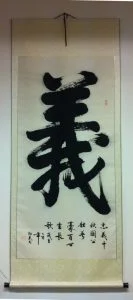Professional Register of
Traditional Chinese Medicine
 Traditional Chinese Medicine is made up of a number of different specialisms, such as Acupuncture-Moxibustion, Herbology, Medical dietetics and Therapeutic exercise.
Traditional Chinese Medicine is made up of a number of different specialisms, such as Acupuncture-Moxibustion, Herbology, Medical dietetics and Therapeutic exercise.
Of these various branches of TCM, Medical Qigong is at once the most ancient and most sophisticated.
Unlike all of the others, it dispenses with the “middle man” – for example acupuncture needles, herbals prescriptions, different food types, various exercises, and the like – and, instead, immediately and directly connects the Qi of the practitioner - with therapeutic intent - to that of the person being treated.
The focused, refined and potentised Qi of the practitioner is transmitted, without intermediary, to the imbalanced or diseased aspect of the client to initiate cure. The practitioner sends out his or her Qi, without touching the patient, to perform the treatment. All forms of TCM treatment strive to boost, reinforce, strengthen and invigorate the Qi.
Acupuncture medicine, for example, employs finest needles, applied to the skin, to drive out unhealthy Qi and restore healthy circulation of optimal Qi. MQG uses the Qi of the practitioner to directly influence and invigorate the smooth flow of Qi within the patient and thereby to remove possible Qi blockages of many different sorts. For more information on Qi click here.
While Medical Qigong is undoubtedly one of the most effective forms of medical intervention known to man, it is also, not surprisingly, one of the most intriguing and challenging endeavours for the TCM medical practitioner to embark upon. It also the most demanding in terms of the time and effort needed to master it.
The utmost dedication and constant hard work is required in order to so refine one’s Qi that it can then be projected externally to another human being to bring about a transformation in their health. The demands placed upon the practitioner who can subsequently sometimes achieve seemingly “miraculous” medical potency could not be otherwise.
Within the context of TCM, there are two distinct aspects of Qigong.
One is the use of the practitioner’s Qi to provide a medical treatment for a client. This is called Medical Qigong (MQG) and is described above. The other is Health-promoting Qigong. This is a form of therapeutic exercise which a client, or indeed an interested individual, can practise on their own in order to improve their own health.
Health-promoting Qigong, also known as Qigong for Health and Wellbeing, is part of Chinese therapeutic exercises. This Qigong (pronounced Cheegung)comprises a set of simple movements, breathing exercises and relaxation/meditation techniques which people can practice on their own at home.
The Irish College of TCM (the affiliated college of the PRTCM) offers short weekend courses in Health-promoting Qigong 5 or 6 times each year. These are open to all adult members of the public.
Your TCM practitioner may suggest that you should attend one of these weekend courses to supplement the Acupuncture TCM treatment that you receive.
Some members of the PRTCM are qualified not only in Acupuncture TCM but also in Medical Qigong. These members have either been trained in China, over a period of several years, by Qigong Masters who were professors at Guangzhou University of TCM in China, or have been trained in Ireland by teachers authorised to do so by these same Qigong Masters in China.
MQG practitioners will only use this treatment method if they feel it is necessary for the client’s individual condition. They may suggest instead using Acupuncture or Chinese Herbal Medicine instead of MQG.
For a list of trained practitioners of MQG click here.
Click here to link to the ICTCM website.
For questions or comments, you can reach us through our Contact Us page.